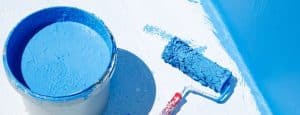Protecting Your Walls With Waterproofing
If you are remodeling or building a home, you will need waterproofers to meet national building code standards.
This is especially important for residents of Australian cities with high humidity or rain, as these weather conditions can keep your walls damp for an extended period of time.
Moisture will penetrate the paint layer and damage the plasterboard walls. This not only has an unsightly appearance but can also lead to mold growth and severe structural damage, necessitating mold remediation.

As a result, the foundation of the house may be jeopardized. A common statistic in the construction industry is that waterproofing accounts for 1.8% of construction costs but accounts for 83% of construction defects.
So, if you want to spend less money and time repairing your home, consider properly waterproofing your walls and having a certifier inspect them.
A properly waterproofed home may also have a higher resale value on the market. Waterproofing your walls effectively prevents mould formation during the wet season and ensures the health and safety of your family.
WHICH AREAS OF YOUR HOUSE NEED TO BE WATERPROOFED?
You must waterproof any areas susceptible to water damage if you want your home to remain structurally sound. As a result, the following areas of your home must be thoroughly waterproofed:
EXTERIOR WALLS
Depending on where you live, the exterior walls of your home are exposed to wind, rain, and even snow. So, if you want to protect your home’s overall appearance and structure, it’s critical to seal the exterior walls.
CELLAR
Basements are frequently flooded due to various factors, including groundwater intrusion and leaking pipes. Because the basement is the closest to the foundation, waterproofing the basement walls can prevent foundation damage.
BATHROOM
Because this area of your home is frequently in contact with water, waterproofing bathroom walls protects against seepage and mould growth. This is one of the most important steps in a bathroom renovation!
ROOFS
Waterproofing your metal roof protects it from extreme weather conditions such as rain, snow, and hail. A severely damaged roof may even collapse, causing irreversible damage to your property.
BALCONIES
Balconies must be waterproofed or have balcony sealing done because they are exposed to rain and are very susceptible to water damage. It is simple to repair any damage to the balcony grout and ensure that the waterproofing remains intact.
SIGNS THAT YOU SHOULD WATERPROOF YOUR WALLS
Here are some important signs you should consult an expert on when waterproofing your walls.
- Your house smells musty and damp
- There is a visible mold growth
- You see water stains on your walls and ceilings
- The paint or wallpaper is peeling in some places
- You have cracks in the walls
- Your walls are bulging downward
Moisture promotes mold growth in homes, which can lead to a variety of respiratory issues in both adults and children. Mould can also make you sick and cause severe allergic reactions in your home.
WAYS TO WATERPROOF A WALL
There are a variety of waterproofing products on the market that homeowners can use to waterproof their own walls. However, if you’ve never worked on a similar home improvement project or are unfamiliar with construction and renovation, it’s best to delegate the task to professionals.
Waterproofing services are provided by a number of companies. Although their prices and techniques differ significantly, they all use more or less similar materials to achieve the desired results.
The following products are most likely to be used depending on which area of your home you want to waterproof.
WATERPROOF CONCRETE COATING
This cementitious coating can be applied to the surface of walls without the need for paint removal. This coating, which is essentially a waterproofing membrane with a polymer-modified cement layer, is a straightforward solution to any seepage and moisture issues.
This type of waterproof coating is commonly used on interior walls, particularly in bathrooms. It is one of the best methods for waterproofing basement walls.
WATERPROOF PAINTS
Waterproof paints for exterior walls typically have the same appearance as regular paints. However, they are much more resistant to rain and heat. They are also easy to apply and can be applied by anyone with a paint roller.
Waterproof paints, when properly applied, form a barrier on the wall surface, protecting it from moisture and mould. Before applying a new coat of paint, prime your bare walls with waterproof primer.
There are three main types of waterproofing paints on the market:
- Paints for masonry
- Acrylic paints
- Epoxy paints
These paints are excellent for waterproofing exterior walls as well as bathrooms. They will, however, most likely require more waterproofing for basements and roofs.
In addition, never apply waterproof paint (or any other type of waterproof coating) to a damp wall. Before you can take such precautions, you must first identify and eliminate the source of the problem.
Regarding your interior walls, keep in mind our tips for selecting the best paint for the various rooms in your home.
SILICONE SEALANT
Waterproof silicone sealant, PVS-like caulk, and waterproof grout are wonderful options to protect the sink area in your kitchen and bathroom. This solution may keep moisture out by sealing the connections between your sink and the wall. This sealant, which the homeowner may easily apply, is commonly used around toilets, bathtubs, and even windows.
Also, you may use silicone sealants to waterproof your walls if they have noticeable fractures on the surface.

SILICATE CONCRETE SEALER
Although the silicate-based concrete sealer is more costly than the other solutions on our list, it is also one of the most effective techniques for waterproofing basement walls, roofs, and other surfaces.
Silicate sealants penetrate the concrete and chemically react with it to generate calcium silicate hydrate. This then fills the concrete pores and produces a moisture barrier. It also boosts the density and strength of the concrete without affecting its look when applied appropriately.
However, the liquid silicate sealer may only be sprayed on unpainted and open surfaces. Furthermore, many coats of this sealer may be necessary to adequately waterproof the surface. The same may be said for different forms of waterproofing materials.
One of the most common techniques for waterproofing a retaining wall is the liquid waterproofing membrane method, which includes spraying on a polymer-modified asphalt membrane.
Qld Waterproofers waterproofs your structure using high-quality materials and a variety of waterproofing alternatives. Our professionals take a professional approach to waterproofing and work hard on each job.
So, do you need assistance?
Contact us right away to get your property waterproofed.
The post Waterproofing Brisbane appeared first on https://e-sites.co.uk
The post Waterproofing Brisbane appeared first on https://gqcentral.co.uk
Comments are closed